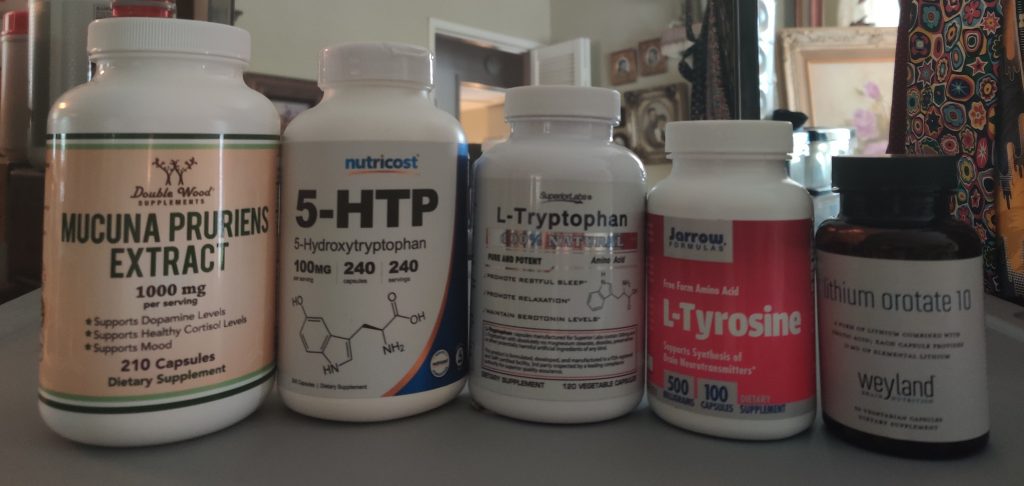This was an amazing tool in my arsenal as I was transition to what I call a species appropriate diet. Now that my diet is what I would call clean I don’t have any use for the following protocol. I never thought I would see the day that I would not be doing something in response to ADHD. A clean body made possible by clean diet makes sober-minded decisions much easier to make. My mind is rather calm these days. I am thankful for what these things helped me accomplish, but I’m even happier to be free of it all. A life with no pills at all is true freedom. Goodbye old friend
I have created my own daily protocol to address any issues related to focus, mood or attention. This also helps me maintain a strong adherence to my body’s natural rhythm’s.
Below you will see a picture containing L-Tryptophan, 5-HTP, L-Tyrosine and L-DOPA(mucuna pruriens) and Lithium Orotate. I take one of each every morning.
PDF List – Serotonin Transporter Inhibitors/Modulators
Serotonin Transporters are integral membrane proteins that transport serotonin from synaptic spaces into presynaptic neurons. Serotonin Transporters function by reuptaking serotonin in the synaptic cleft, effectively terminating the function of serotonin and halting neuronal transmission. Serotonin reuptake is a critical process to prevent overstimulation of nerves.
Serotonin transporter regulates extracellular levels of serotonin (5-HydroxyTryPtamine[5HTP], 5HT) in the brain by transporting 5HT into neurons and glial cells. The human serotonin transporter(hSERT) is the primary target for drugs used in the treatment of emotional disorders, including depression. hSERT belongs to the solute carrier 6 family that includes a bacterial leucine transporter (LeuT), for which a high resolution crystal structure has become available.
Norepinephrine and Epinephrine are about EFFORT. Just effort with no subjective label on them good or bad. Sheer will to act.
Dopamine is about reward but even more so about motivation and pursuit of rewards. Outward focused.
Serotonin is also a reward but one from a more relaxed state of being related to things like sleep, meditation and especially gratitude. Introspective.
Serotonin – A chemical that has a wide variety of functions in the human body. It is sometimes called the happy chemical, because it contributes to wellbeing and happiness. The scientific name for serotonin is 5-hydroxytryptamine, or 5-HT. It is mainly found in the brain, bowels, and blood platelets.
Neurotransmitters, such as serotonin and glutamate show a decline in output with aging.
Dopamine – The dopamine system plays a central role in several significant medical conditions, including Parkinson’s disease, attention deficit hyperactivity disorder, Tourette syndrome, schizophrenia, bipolar disorder, and addiction. A number of studies have reported an age-related decline in dopamine synthesis and dopamine receptor density (i.e., the number of receptors) in the brain.
Norepinephrine – The general function of norepinephrine is to mobilize the brain and body for action. Norepinephrine release is lowest during sleep, rises during wakefulness, and reaches much higher levels during situations of stress or danger, in the so-called fight-or-flight response.
Epinephrine – Adrenaline, also known as epinephrine, is a hormone and medication. Adrenaline is normally produced by both the adrenal glands and a small number of neurons in the medulla oblongata, where it acts as a neurotransmitter involved in regulating visceral functions (e.g., respiration).
Lithium Orotate – Tyrosine hydroxylase is the rate-limiting enzyme of catecholamine synthesis. It catalyzes the hydroxylation of tyrosine to L-DOPA. The catecholamines dopamine, epinephrine and norepinephrine are the products of the pathway, important as hormones and neurotransmitters in both the central and peripheral nervous systems.
Lithium increases tyrosine hydroxylase levels. It also acts upon the inputs and outputs of serotonin transporters.
L-Tyrosine – Generally speaking, Tyrosine represents a starting material for neurotransmitters. This amino acid also increases plasma neurotransmitter levels, especially dopamine and noradrenalin, as well as participates in the synthesis of enkephalins providing pain-relieving effects in the body. dopamine is also essential for the mental functioning and mood, and therefore is widely used to treat mild depression and even stimulate sex drive.
This amino acid, if obtained in full, helps reduce stress, improves mental alertness and mood, and even acts as an appetite suppressant. It is essential for the production of a number of important hormones like thyroxin, which plays a key role in regulating metabolism, mental health, skin health, and the human growth rate. Besides, it is known for reducing body fat content, for helping to produce skin and hair pigment and for positively influencing thyroid, pituitary and adrenal gland.
L-Dopa(mucuna pruriens) – Tyrosine hydroxylase catalyzes the hydroxylation of tyrosine to L-DOPA. The catecholamines dopamine, epinephrine and norepinephrine are the products of the pathway, important as hormones and neurotransmitters in both the central and peripheral nervous systems.
L-Tryptophan – Tryptophan shortages are believed to cause depression, insomnia, and anxiety.
5-Hydroxytryptophan(5-HTP) – or oxitriptan, is a naturally occurring amino acid and chemical precursor as well as a metabolic intermediate in the biosynthesis of the neurotransmitter serotonin.
5-HTP is decarboxylated to serotonin by the enzyme aromatic-L-amino-acid decarboxylase with the help of vitamin B6. This reaction occurs both in nervous tissue and in the liver. 5-HTP crosses the blood–brain barrier, while 5-HT does not. Excess 5-HTP, especially when administered with vitamin B6, is thought to be metabolized and excreted.
~Additional Reading

